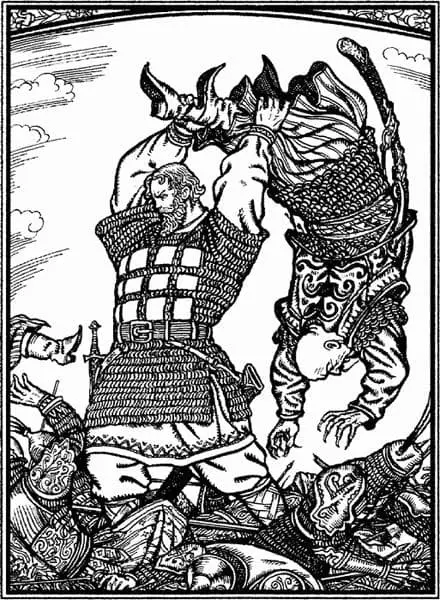Character History
Kalin-king - the epic character, the hero of the legends about Ilya Muromster. This is the Tatar prince, the description of which in the legends is converged with the image of Mamay, but the initial origin of Kalina was completely different.History of character appearance
In the names of the hero called Galin, Cain or Kalin King, Son Kalinovich. The origin of the name to the end is not clear: according to one of the versions, it comes from the word KALUŋ - "Fat", "fat", other researchers associate it with the Kolun Turkka, the character of the ancient epic "Shahnama", or are subject to reference to the name of the river river. The values associated with the berry vibrant or the word "rolling" are also possible.

In the eponymists, Kalina is often referred to as a dog, and not only enemies, but also their own subjects. For example, a ambassador requiring Vladimir to pass Kiev reads the letter of his sovereign, named His "Calin-Tsar" dog.
The historic prototype of the hero is the king of Kalian, who ruled in Bulgaria in 1197-1207. He fought with the Crusaders and for his ruthlessness was nicknamed by a dog and Romeokton ("Romeev's killer"). During the siege of the Fesalonik in 1207, Kalian died as a result of a sudden illness or conspiracy, after which his army had to retreat.
The sudden death of the king, who played the Greek's hand, became the basis of numerous legends. According to legend, Dmitry Solunsky himself became the killer of Kaloyana, who once night came the enemy and killed him with a swarm of a spear in his heart. The images of the saint, where he in military armor turns the cruel king to the ground. Later, the legend of the Kaloyan moved to the Balkans and Rus. Fairy tales about the militant "Tsar Kaliacho" have been preserved and at Bulgarians.
Over the years, the idea of the Kaloyan was blurred, becoming a collective manner of "Pogan Tatar" in Russia. In this regard, he was often mixed with the image of Mamaya, and the epics about him brightly reflected the entire depth of the hatred of the Russian people to the invaders. However, the fact that Kalin did not originate to Tatars initially, confirmed by his title - everywhere he was mentioned as a king, and the Tatar leader would be more called Khan or Kagan.
Characteristics of the appearance of Kalina in the legends is not preserved. The nickname "thick, greasy" could be not a description of the appearance, but in a figurative sense, meaning greeding to gold, lands and other wealth. In the pictures to the editions of the epics, Kalin is depicted by a powerful warrior in luxurious armor, with a cunning Asian square and subtle mustache.
Biography and image of Kalina-King
In the plot of later Russian legends Kalin - the king of extensive lands, who wished to own and Kiev. Having enlisted with the support of the rulers of 40 other countries, he sends a letter to Vladimir a letter demanding to pass the capital without a fight, and at the same time to prepare a feast so that his troops will celebrate victory. The Kiev ruler pulls out a delay from Kalina at 3 years, 3 months and 3 days, but there is no one to help out the city. Ilya Muromsz Vladimir considers those who died, because he ordered him for the provinity himself to throw him into the dungeon and worry hunger. Fortunately, the bogatyr still survived thanks to the daughter of Vladimir, who all this time secretly wore him food. Having learned about this, the prince relies Ilya and asks to save the city; He generously forgives resentment and goes to execute.Bogatyr saddles the horse and goes to Kalina - on one of the versions to ask another deferment, on the other - to fight the enemy in honest battle. An interesting fact - in all the variants of the epics, subpoples are certainly mentioned with smolny people who have to overcome Ilya Muromets along the way. This is a clear reference to a specific admission of battles used by the Tatar troops; Even on the icon of Dmitry Solunsky under the hooves, his horse is depicted black pit.
Once in the hands of Kalina, Bogatyr is trying to negotiate with him "peace", but unsuccessfully. In another version of history, the enemy king himself tries to lean Ilya Muromsz to his side with generous gifts and promises ("Murz will do you") and grieves on the refusal. One way or another, the parties do not agree, and the Russian warrior, tied by horse harness, lead to execute. But to overcome Ilya is not so simple: freeing his hands, he grabs the nearest Tatar and, waving them, like a pan, clears the road and "sticks" all the enemy army. Amazed him by force, Kalin retreats and "throws" to return to Russia, where such mighty warriors live. In an alternative ending, Ilya does not simply drive the invader, but he himself knocks the tribute from him in favor of Kiev.
Quotes
I have been driving me from my hand here and the polarity. I have to squeeze you to burn you, but for the courage, I have mercy. Says to tell me, lying at my feet!Bibliography
- "Ilya Muromets and Kalin-Tsar"
Filmography
- 1956 - "Ilya Murom
